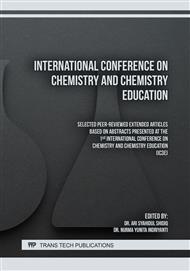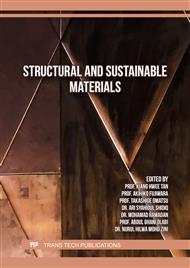[1]
H. Suprihatin, "Kandungan Organik Limbah Cair Industri Batik Jetis Sidoarjo Dan Alternatif Pengolahannya [Organic Content of Liquid Waste in the Batik Jetis Industry in Sidoarjo and its Alternative Processing]," Pus. Penelit. Lingkung. Hidup Univ. Riau, p.130–138, 2014.
DOI: 10.33084/mitl.v3i1.640
Google Scholar
[2]
M. W. Kurniawan, P. P. -, and S. S. -, "Strategi Pengelolaan Air Limbah Sentra Umkm Batik Yang Berkelanjutan Di Kabupaten Sukoharjo," J. Ilmu Lingkung., vol. 11, no. 2, p.62, 2014.
DOI: 10.14710/jil.11.2.62-72
Google Scholar
[3]
N. Natalina and H. Firdaus, "Penurunan Kadar Kromium Heksavalen (Cr6+) Dalam Limbah Batik Menggunakan Limbah Udang (Kitosan)," Teknik, vol. 38, no. 2, p.99, 2018.
DOI: 10.14710/teknik.v38i2.13403
Google Scholar
[4]
H. R. Rashidi, N. M. N. Sulaiman, and N. A. Hashim, "Batik Industry Synthetic Wastewater Treatment Using Nanofiltration Membrane," Procedia Eng., vol. 44, p.2010–2012, 2012.
DOI: 10.1016/j.proeng.2012.09.025
Google Scholar
[5]
S. Wilbur et al., Toxicological Profile for Chromium. Agency for Toxic Substances and Disease Registry (US), 2012.
Google Scholar
[6]
Goyer, R. A. and T. W. Clarkson, "Toxic effects of metal," Casarett and Doull's Toxicology : The Basic Science of Poisons. New York: McGraw-Hill, 2007.
Google Scholar
[7]
M. Ur Rahman, S. Gul, and M. Z. Ul Haq, "Reduction of chromium(VI) by locally isolated Pseudomonas sp. C-171," Turkish J. Biol., vol. 31, no. 3, p.161–166, 2007.
Google Scholar
[8]
L. Chandana, K. Krushnamurty, D. Suryakala, and C. Subrahmanyam, "Low-cost adsorbent derived from the coconut shell for the removal of hexavalent chromium from aqueous medium," Mater. Today Proc., vol. 26, no. August, p.44–51, 2018.
DOI: 10.1016/j.matpr.2019.04.205
Google Scholar
[9]
H. Wang, X. Song, H. Zhang, P. Tan, and F. Kong, "Removal of hexavalent chromium in dual-chamber microbial fuel cells separated by different ion exchange membranes," J. Hazard. Mater., vol. 384, p.121459, 2020.
DOI: 10.1016/j.jhazmat.2019.121459
Google Scholar
[10]
T. Ngoc-Dan Cao et al., "Simultaneous hexavalent chromium removal, water reclamation and electricity generation in osmotic bio-electrochemical system," Sep. Purif. Technol., vol. 263, p.118155, 2021.
DOI: 10.1016/j.seppur.2020.118155
Google Scholar
[11]
N. Khosroshahi, M. Bakhtian, and V. Safarifard, "Mechanochemical synthesis of ferrite/MOF nanocomposite: Efficient photocatalyst for the removal of meropenem and hexavalent chromium from water," J. Photochem. Photobiol. A Chem., vol. 431, p.114033, 2022.
DOI: 10.1016/j.jphotochem.2022.114033
Google Scholar
[12]
A. Raja et al., "Fabrication of effective visible-light-driven ternary Z-scheme ZnO-Ag-BiVO4 heterostructured photocatalyst for hexavalent chromium reduction," Sep. Purif. Technol., vol. 252, p.117446, 2020.
DOI: 10.1016/j.seppur.2020.117446
Google Scholar
[13]
S. U. Khan, D. T. Islam, I. H. Farooqi, S. Ayub, and F. Basheer, "Hexavalent chromium removal in an electrocoagulation column reactor: Process optimization using CCD, adsorption kinetics and pH modulated sludge formation," Process Saf. Environ. Prot., vol. 122, p.118–130, 2019.
DOI: 10.1016/j.psep.2018.11.024
Google Scholar
[14]
F. F. Rosyida, D. Purwonugroho, and R. T. Tjahjanto, "Adsorpsi Timbal ( II ) Menggunakan Biomassa Azollamicrophylla Diesterifikasi dengan Asam Sitrat," vol. 2, no. 2, p.541–547, 2014.
Google Scholar
[15]
S. K. Dhidan, "Removal of Phenolic Compuns from Aqueous Solution by Adsorpsion Onto Actived Carbons Prepared from Date Stones by Chemical Activation With FeCl 3," J. Eng., vol. 18, no. 1, p.63–77, 2012.
DOI: 10.31026/j.eng.2012.01.05
Google Scholar
[16]
W. Widiyastuti, M. Fahrudin Rois, N. M. I. P. Suari, and H. Setyawan, "Activated carbon nanofibers derived from coconut shell charcoal for dye removal application," Adv. Powder Technol., vol. 31, no. 8, p.3267–3273, 2020.
DOI: 10.1016/j.apt.2020.06.012
Google Scholar
[17]
K. A. Adegoke et al., "Sawdust-biomass based materials for sequestration of organic and inorganic pollutants and potential for engineering applications," Curr. Res. Green Sustain. Chem., vol. 5, no. January, p.100274, 2022.
DOI: 10.1016/j.crgsc.2022.100274
Google Scholar
[18]
A. Ramirez, R. Ocampo, S. Giraldo, E. Padilla, E. Flórez, and N. Acelas, "Removal of Cr (VI) from an aqueous solution using an activated carbon obtained from teakwood sawdust: Kinetics, equilibrium, and density functional theory calculations," J. Environ. Chem. Eng., vol. 8, no. 2, p.103702, 2020.
DOI: 10.1016/j.jece.2020.103702
Google Scholar
[19]
S. Hartanto and Ratnawati, "Pembuatan Karbon Aktif dari Tempurung Kelapa Sawit dengan Metode Aktivasi Kimia," J. Sains Mater. Indones., vol. 12, no. 1, p.12–16, 2010.
DOI: 10.22146/ijl.v1i2.44743
Google Scholar
[20]
N. Mastiani, V. Amalia, and T. D. Rosahdi, "Potensi Penggunaan Tempurung Kelapa sebagai Adsorben Ion Logam Fe(III)," al-Kimiya, vol. 5, no. 1, p.42–47, 2018.
DOI: 10.15575/ak.v5i1.3731
Google Scholar
[21]
S. Kadir, P. Darmadji, C. Hidayat, and Supriyadi, "Fractionation And Identification Of Volatile Compounds In Liquid Smoke From Hybrid Coconut Shell," Agritech, vol. 30, no. 2, p.57–67, 2010.
Google Scholar
[22]
H. K. Yağmur and İ. Kaya, "Synthesis and characterization of magnetic ZnCl2-activated carbon produced from coconut shell for the adsorption of methylene blue," J. Mol. Struct., vol. 1232, 2021.
DOI: 10.1016/j.molstruc.2021.130071
Google Scholar
[23]
S. Bhowmik, V. Chakraborty, and P. Das, "Batch adsorption of indigo carmine on activated carbon prepared from sawdust: A comparative study and optimization of operating conditions using Response Surface Methodology," Results in Surfaces and Interfaces, vol. 3, no. March, p.100011, 2021.
DOI: 10.1016/j.rsurfi.2021.100011
Google Scholar
[24]
E. Kurniati, "Pemanfaatan Cangkang Kelapa Sawit Sebagai Arang Aktif," J. Penelit. Ilmu Tek., vol. 8, no. 2, p.96–103, 2008.
Google Scholar
[25]
F. (2011). Dwi, FetiDwi, "Jurnal Kimia Sains dan Aplikasi Sintesis Arang Aktif dari Tempurung Kelapa dan Aplikasinya," J. Kim. Sains dan Apl., vol. 14, no. 3, p.72–76, 2011.
DOI: 10.14710/jksa.14.3.72-76
Google Scholar
[26]
H. Marsh and F. Rodríguez-Reinoso, "Activation Processes (Chemical)," H. Marsh and F. B. T.-A. C. Rodríguez-Reinoso, Eds. Oxford: Elsevier Science Ltd, 2006, p.322–365.
DOI: 10.1016/B978-008044463-5/50020-0
Google Scholar
[27]
S. M. Villota et al., "Microwave-Assisted Activation of Waste Cocoa Pod Husk by H 3 PO 4 and KOH - Comparative Insight into Textural Properties and Pore Development," ACS Omega, vol. 4, no. 4, p.7088–7095, 2019.
DOI: 10.1021/acsomega.8b03514
Google Scholar
[28]
M. Gueye, Y. Richardson, F. T. Kafack, and J. Blin, "High efficiency activated carbons from African biomass residues for the removal of chromium(VI) from wastewater," J. Environ. Chem. Eng., vol. 2, no. 1, p.273–281, 2014.
DOI: 10.1016/j.jece.2013.12.014
Google Scholar
[29]
J. Chwastowski, P. Staroń, H. Kołoczek, and M. Banach, "Adsorption of hexavalent chromium from aqueous solutions using Canadian peat and coconut fiber," J. Mol. Liq., vol. 248, p.981–989, 2017.
DOI: 10.1016/j.molliq.2017.10.152
Google Scholar
[30]
F. Kaouah, S. Boumaza, T. Berrama, M. Trari, and Z. Bendjama, "Preparation and characterization of activated carbon from wild olive cores (oleaster) by H3PO4 for the removal of Basic Red 46," J. Clean. Prod., vol. 54, p.296–306, 2013.
DOI: 10.1016/j.jclepro.2013.04.038
Google Scholar
[31]
Z. He, L. Qu, Z. Wang, J. Qian, and S. Yi, "Effects of zinc chloride–silicone oil treatment on wood dimensional stability, chemical components, thermal decomposition and its mechanism," Sci. Rep., vol. 9, no. 1, p.1–7, 2019.
DOI: 10.1038/s41598-018-38317-5
Google Scholar
[32]
T. Budinova et al., "Characterization and application of activated carbon produced by H3PO4 and water vapor activation," Fuel Process. Technol., vol. 87, no. 10, p.899–905, 2006.
DOI: 10.1016/j.fuproc.2006.06.005
Google Scholar
[33]
N. Ayawei, A. N. Ebelegi, and D. Wankasi, "Modelling and Interpretation of Adsorption Isotherms," J. Chem., vol. 2017, p.3039817, 2017.
DOI: 10.1155/2017/3039817
Google Scholar
[34]
A. R. Abdul Rahim et al., "Effective carbonaceous desiccated coconut waste adsorbent for application of heavy metal uptakes by adsorption: Equilibrium, kinetic and thermodynamics analysis," Biomass and Bioenergy, vol. 142, no. September, p.105805, 2020.
DOI: 10.1016/j.biombioe.2020.105805
Google Scholar
[35]
M. M. A. Daouda, A. V. O. Akowanou, S. E. R. Mahunon, C. K. Adjinda, M. P. Aina, and P. Drogui, "Optimal removal of diclofenac and amoxicillin by activated carbon prepared from coconut shell through response surface methodology," South African J. Chem. Eng., vol. 38, no. July, p.78–89, 2021.
DOI: 10.1016/j.sajce.2021.08.004
Google Scholar
[36]
J. Kodali, S. Talasila, B. Arunraj, and R. Nagarathnam, "Activated Coconut Charcoal as a super adsorbent for the removal of organophosphorous pesticide monocrotophos from water," Case Stud. Chem. Environ. Eng., vol. 3, no. January, p.100099, 2021.
DOI: 10.1016/j.cscee.2021.100099
Google Scholar
[37]
R. Kusumawardani, T. A. Zaharah, and L. Destiarti, "Adsorpsi kadmium(II) menggunakan adsorben selulosa ampas tebu teraktivasi asam nitrat," J. Kim. Khatulistiwa, vol. 7, no. 3, p.75–83, 2018.
Google Scholar
[38]
I. A. Larasati et al., "Proses Delignifikasi Kandungan Lignoselulosa Serbuk Bambu Betung dengan Variasi NaOH dan Tekanan," J. Keteknikan Pertan. Trop. dan Biosist., vol. 7, no. 3, p.235–244, 2019.
DOI: 10.21776/ub.jkptb.2019.007.03.03
Google Scholar
[39]
E. A. Wulandari and Sukesi, "Preparasi Penentuan Kadar Logam Pb , Cd dan Cu dalam Nugget Ayam Rumput Laut Merah (Eucheuma Cottonii)," J. Sains Dan Seni Pomits, vol. 2, no. 2, p.15–17, 2013.
DOI: 10.14710/jnc.v2i1.2121
Google Scholar



